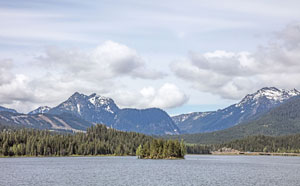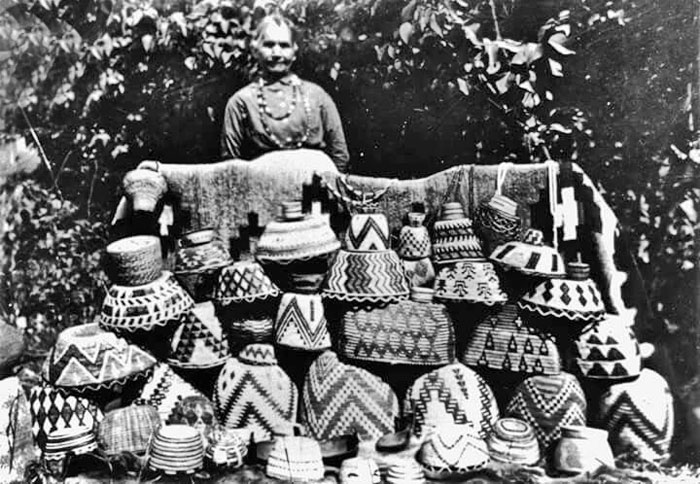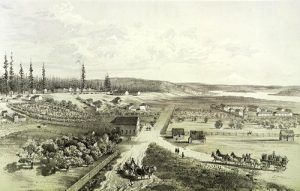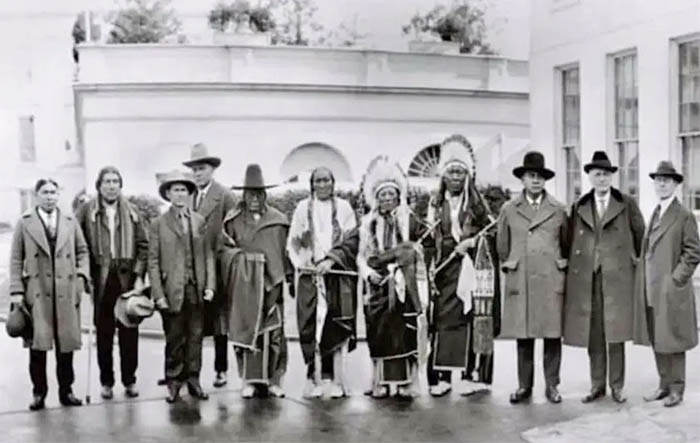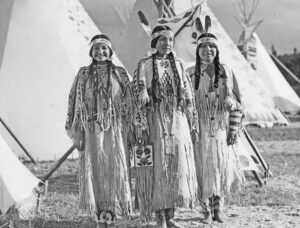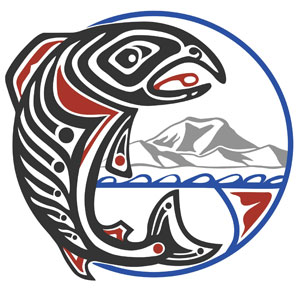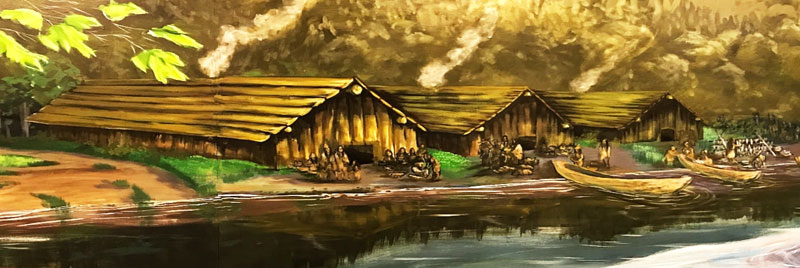
Cowlitz Indian Village courtesy Cowlitz Indian Tribe.
The Cowlitz tribe, who spoke their own language, belong to the Salishan family of languages among Northwest Coast indigenous peoples in Washington.
Later, the Upper Cowlitz adopted the Sahaptin language from east of the Cascade Mountains. The Cowlitz people were historically based along the Cowlitz and Lewis Rivers and had a strong presence at Fort Vancouver.
Cowlitz villages once dotted rivers that drained into larger rivers of the Columbia watershed. From the high mountains to the lowlands, these waterways provided transport with efficiently constructed canoes. An abundance of renewable trees, shrubs, plants, stones, shells, animals, and animal hides were harvested and used for lodging, canoes, clothing, food, bowls, baskets, storage containers, weaponry, and tools.
Before European contact, the different areas were so expansive that different languages developed. Constant intermarriages between near and distant villages ensured a steady flow of language interchange, and the Cowlitz became adept at speaking several languages. This was very useful in trading expeditions. On the rivers, they used snub-nosed canoes capable of negotiating rapids. Barter items included slaves, horses, various plant and meat foodstuffs, pelts, hides, and baskets. They also exchanged items through gaming, horse racing, and pow-wows.
Each village had religious practices and ceremonies for harvests and events. These included prayers — spoken, sung, or meditated. Tribal members performed dances and songs, seeking to ensure the availability of food and to avoid evil.
Harvest ceremonies encompassed celebrations with storytelling, drummed prayer songs, visitation, and children’s games. Potlatch ceremonies such as weddings, births, naming, the passage of life, and other special events often featured pow-wow dances.
The Cowlitz utilized sweat lodges where adults or near adults cleansed their bodies and minds of toxins. These sessions were sanctified by a sprinkling of sage and cedar, accompanied by songs and prayers.
Upon reaching adolescence, Cowlitz youths departed on fasting quests to seek visions of a spirit guide to help them become productive members of the tribe. The signs that one might encounter during a vision quest were seen as messages from the spirit world, and the individual’s response to these signs was believed to be an essential part of the quest.
Individual spiritual guidance was also sought for a life well-lived, family, and village. These quests are often seen as a way to gain personal insight and spiritual connection through fasting, prayer, and meditation. These insights or skills derived from the quest were seen as gifts from the spirit world.
The Cowlitz practiced head flattening, which was seen as a mark of freedom and intellect. The process involved placing an infant child onto a wooden board and applying pressure to the forehead, resulting in a distinctive wedge shape of the skull.
The Cowlitz were also known for their skilled basket weaving, producing coiled baskets with strong geometric designs. These were made of bear grass, cedar root, horsetail root, and cedar bark and were used to gather berries and fruits. Using brightly colored pigments made from fruits and vegetables like beets or blackberries added to the beauty of these baskets.
The earliest historical accounts of the Cowlitz began in 1811 with the arrival of Pacific Fur Company agents out of Astoria, Oregon. The second engagement between the Cowlitz and white settlers occurred after the Candian-owned North West Company, which had bought out the Pacific Fur Company in 1813, dispatched hunters and trappers, including Iroquois Indians, up the Cowlitz River.
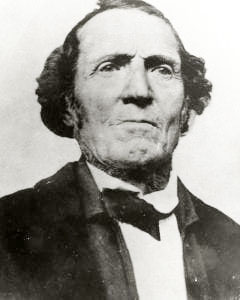
Simon Plamondon
That year French-Canadian Simon Plamondon of Quebec, Canada, arrived on the Columbia River in 1813 with his brother Joseph. The North West Company at Fort Astoria, Oregon, in 1816, soon hired them.
Plamondon made his first trip up the Cowlitz River to the Cowlitz Prairie in 1818 while on a mission to explore this vast unknown region. After a two-day canoe trip up the river, they reached the Cowlitz landing. The Cowlitz tribe had used this canoe landing longer than anyone could remember. After Plamondon and his party set foot on the river bank, they were immediately captured by members of the Lower Cowlitz band. Their captors brought the prisoners to Chief Scanewa, the leader of the Lower Cowlitz tribe, to learn their fate. The Chief then decided to make them his personal slaves.
He was then asked to stay with Scanewa’s tribe and to prove his loyalty through the exchange of goods for furs. Once he had gained the trust of the tribe, he was rewarded with the marriage of Chief Scanewea’s daughter, Thas-e-muth. The couple would have four children. When Chief Scanewea passed, Plamondon inherited most of his land and settled down with his wife on the Cowlitz Prairie, where the couple had four children.
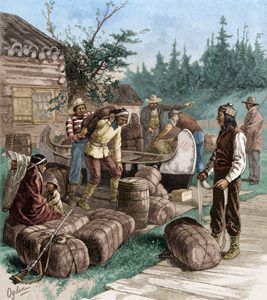
Hudson’s Bay Company traders by Henry Alexander Ogden.
In 1821, the Hudson’s Bay Company absorbed the North West Company, and Plamondon worked for the company as a trapper and voyageur. The opening into Cowlitz country allowed the Hudson Bay Company to trade with the natives.
An epidemic in 1829 and 1830, believed to be a virulent Asian influenza, occurred within the region’s tribes, with villages becoming brutal scenes of sickness and death. The disease, carried in by Captain John Domines’ American ship Owyhee, devastated the Cowlitz people, and populations dropped precipitously.
Plamondon was employed with the Hudson’s Bay Company until 1837 and, in 1838, oversaw the building of Cowlitz Farm under the Puget Sound Agricultural Company, the Hudson’s Bay Company agricultural subsidiary.
The first European who attempted to convert the Cowlitz to Christianity was Herbert Beaver, an Anglican missionary who settled with his wife at Fort Vancouver in 1836. The couple wanted to begin work with the Cowlitz tribe, only 50 miles southeast of Fort Vancouver. When an intermittent fever broke out, Beaver vaccinated nearly 120 Lewis River Cowlitzes.
However, growing tensions with John McLoughlin, the head at Fort Vancouver, prevented the couple from having any influence over the tribe. After conflicts arose with McLoughlin, Beaver and his wife returned to London in 1838.
Later that same year, in December 1838, Catholic missionaries began to visit the Cowlitz tribe, including François N. Blanchet, a Roman Catholic Priest, who arrived near Toledo, Washington, and established St. Francis Xavier Mission. Once optimistic, he became discouraged when the Cowlitz tribe did not fully immerse themselves into Catholicism and instead held onto their Native spirituality. In response, a replacement, Father Modeste Demers, continued with Catholic teachings and baptizing. However, he was as pessimistic as his predecessor and left.
With the arrival of American settlers, conflicts arose over land claims. The 1846 Oregon Treaty gave the U.S. Government power back over once-owned British lands of the Hudson’s Bay Company. With British influence and French-Canadian fur trappers out of the picture, newly appointed Washington governor Isaac Stevens drafted four main treaty negotiations. The Chehalis River Treaty, which included the Cowlitz tribe, was the last negotiation for Stevens. However, his refusal to listen to the tribe leader’s negotiations and concerns led to the document never being signed.
Another fever struck the tribe during this time, and Stevens’s assistant George Gibbs determined that “the Cowlitz, a once numerous and powerful tribe, are now insignificant and fast disappearing.”
The principal aims of chiefs were to establish cooperation with the federal government and a permanent Cowlitz territory. Two treaties were negotiated in the middle 1800s. Congress failed to ratify the first one. In 1855, during a second treaty session with territorial governor Isaac Stevens, the Cowlitz refused to become parties to a document that would eliminate their rights to traditional homelands, then relegate them to the alien coastal Quinault reservation. The treaty collapse led to the United States government confiscating territory and resources without the Cowlitz’s assent.
Consequently, this led to the Indian Wars of 1855-1856 between the Indians and whites, in which the U.S. Army was called to settle disputes with Indian tribes. The Cowlitz tribe remained neutral because the government promised them reservation lands if they remained peaceful. However, when they returned home, they found their land destroyed and their property stolen.
There were four tribal groups of Cowlitz people in various areas:
Upper Cowlitz – True mountain dwellers who lived in the upper meadows and prairies, they lived in proximity to mountain streams and headwaters of rivers. Sometimes called Stick Indians, they occupied and controlled 14 villages along the Upper Cowlitz River, other villages along the Cispus River, and the Tilton River. They were adept in hunting mountain goats for food, clothing, and utensils. They had a unique skill for weaving goat hair and fur into blankets and clothing for families, prized gifts, and trade items.
They frequently interacted with their Upper and Lower Yakama and Klickitat kin, who lived on the east side of the Cascade Range and spoke Sahaptin. Over time, their populations included a constant pattern of intermarriages between Salish Cowlitz and tribal people east of the Cascades. Their name Taitnapam indicates they originally came from east of the Cascades along the Tieton River. Today they are identified as Sahaptin-speaking Taidnapam, meaning “People of the Tieton River.″
Lower Cowlit – Predominantly Salish in nature and manner of speech, they were known as “The People Who Seek Their Medicine Spirit.” They occupied 30 villages along the Lower Cowlitz River and other villages along the Toutle River. Today the majority are enrolled within the Cowlitz Indian Tribe; some are part of the Quinault Indian Nation, and some are with Confederated Tribes of the Chehalis Reservation.
Lewis River Cowlitz – Sometimes called Lewis River Chinook, they are considered a regional group of Taidnapam. Today, they are part of the Confederated Tribes and Bands of the Yakama Nation.
Mountain Cowlitz – Also known as the Kwalhiokwa Cowlitz, they lived between the Upper Chehalis River in the north and the Willapa Hills to the south. They intermarried with Salish-speaking Upper Chehalis and the now-extinct Northern Athapaskan-speaking Willapa. Today, they are part of the Confederated Tribes of the Chehalis Reservation.
In 1906 the tribe, under Chief Atwin Stockum, began formal political relations with the United States.
In 1912, the Cowlitz tribe was reorganized, and many cultural traditions were revived.
In 1924 the Cowlitz sent Frank Iyall as a delegate to congress for the American Indian Citizenship Act. He also served as a delegate for the recognition of the Cowlitz Indian Tribe, which received approval from congress but a veto from President Calvin Coolidge.
The Cowlitz Indian Tribe has had its constitutional elective tribal council system of government since 1950.
In the 1960s, Dale M. Kinkade conducted interviews and audio recordings with Emma Mesplie and Lucy Foster for the Cowlitz Language, which became much of the basis for the Lower Cowlitz dictionary the Cowlitz Indian Tribe uses today.
The Cowlitz were federally acknowledged in February 2000 and was reaffirmed in 2002. The 152-acre Cowlitz Reservation was established in 2010 near Ridgefield, in Clark County, Washington. The Cowlitz Indian Tribe is headquartered in Longview, Washington. The tribe is governed by a democratically elected board of tribal council members. The Cowlitz Indian Tribe has built the Ilani Casino Resort with ten restaurants and plans for a hotel near Ridgefield, Washington.
Other Cowlitz people are enrolled in the Confederated Tribes of the Chehalis Reservation, Confederated Tribes and Bands of the Yakima Nation, and Quinault Indian Nation.
More Information:
Cowlitz Indian Tribe
1055 9th Ave, Longview, WA 98632
360-577-8140
©Kathy Alexander/Legends of America, updated March 2023.
Also See:
Indigenous Americans Long Path to U.S. Citizenship
Native American Photo Galleries
Native Americans – First Owners of America
Sources:
Cowlitz Indian Tribe
Pacific Highway
U-S-History
Wikipedia – Cowlitz Tribe
Wikipedia – Cowlitz People

